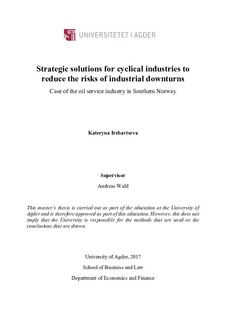| dc.description.abstract | Cyclical industries are exposed to unpredictable industrial downturns caused by fluctuations in
market conditions. Changing prices for natural resources used for industrial production are
among the driving forces that can lead to industrial cyclicality. This was the case of the oil
prices decrease three years ago, which led to an industrial downturn in the oil and gas, and
consequently, the oil service industries worldwide. A vital industry for many countries, which
is unprotected from the industrial cyclicality, the oil service industry has been selected as the
case for this research. Due to time and resources limitations, the geographical area for this
research has been limited to the Southern Norway.
Industrial cycles directly affect firms’ behavior and strategy development processes. During
industrial downturns, a lot of pressure lays on the shoulders of the managers of companies
involved in cyclical industries. The appropriate strategic solutions to mitigate the negative
effect of such downturns and strategically prepare for other similar downturns in the future are
crucial for companies working in cyclical industries. The right resources and competences on
the management level are essential for appropriate strategy development and execution.
Based on a theoretical and conceptual framework of the field of corporate strategy, this research
has explored how companies from the oil service industry react to the industrial downturn. The
Ansoff Matrix, complemented by the strategic alliance option, was empirically applied to find
optimal strategies. The main findings are that product development and market development
strategies are the most feasible strategic directions for oil service companies. Strategic alliances
can be used to facilitate the implementation of the mentioned directions, but are limited to the
knowledge-sharing capacity of the companies involved.
Generally, the main conclusion is that, due to technological evolution of cyclical industries and
the increased role of digitalization in their business processes, the further strategic development
of such industries should adopt cyclic business models and innovation models instead of the
outdated linear models. The strategy development and implementation process itself is
suggested to be cyclic, involving managers, engineers, academia, and customers in strategy
making, to achieve the best strategic solutions to reduce the risks of industrial cyclicality. | nb_NO |

